Out of all the states in the United States, Alaska has some of the most unique for the northern hemisphere. Native trees are an essential part of nature, especially for wildlife. They function as a part of a biosphere and add a lovely look to the world. So, what are the most iconic trees native to Alaska? We’ll take a look at the most well-known trees that are native to the state.
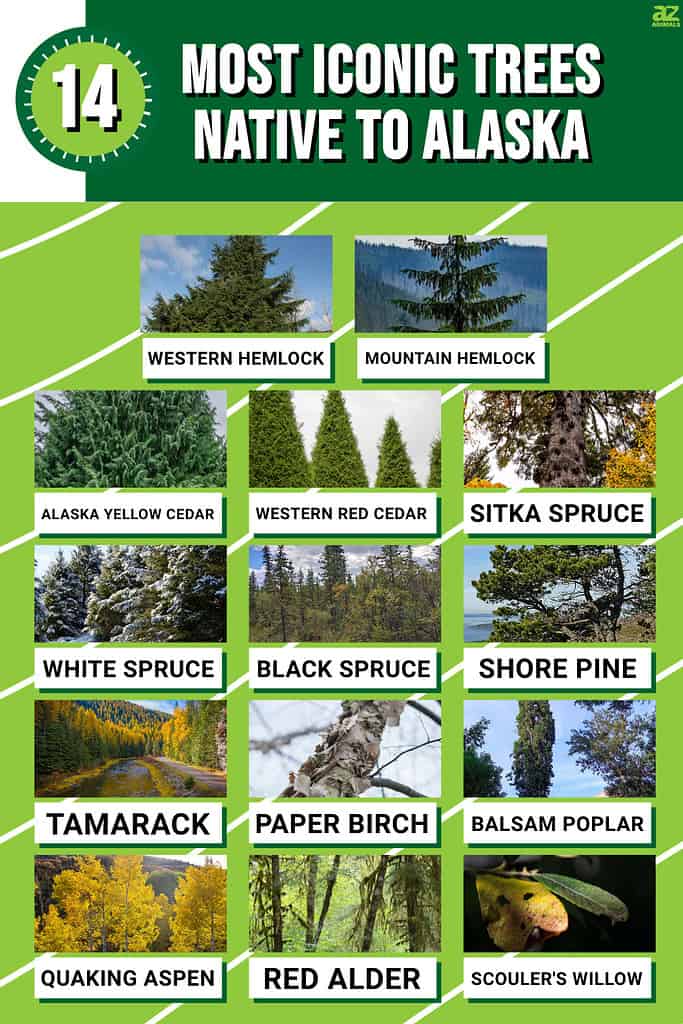
What Trees Are Native to Alaska?
The state of Alaska has 32 native tree species. With the state having over 663,268 square miles of landmass and plenty of different environment types, each has its own trees. Each tree adds to the state’s richness and provides a home to wildlife. The most common native tree in Alaska is the White Spruce, a favored tree for red squirrels and spruce grouse.
However, with the state’s vast size, different types of trees dominate each region. Alaska is broken down into five regions, which include:
- Inside Passage
- Southcentral
- Interior
- Arctic
- Southwest
Each of these regions has drastically different climates and environments. Most trees can be found in the southeastern area, as these have better conditions for plants. However, there are still a few in the interior and northern regions.
#1: Western Hemlock (Tsuga heterophylla)
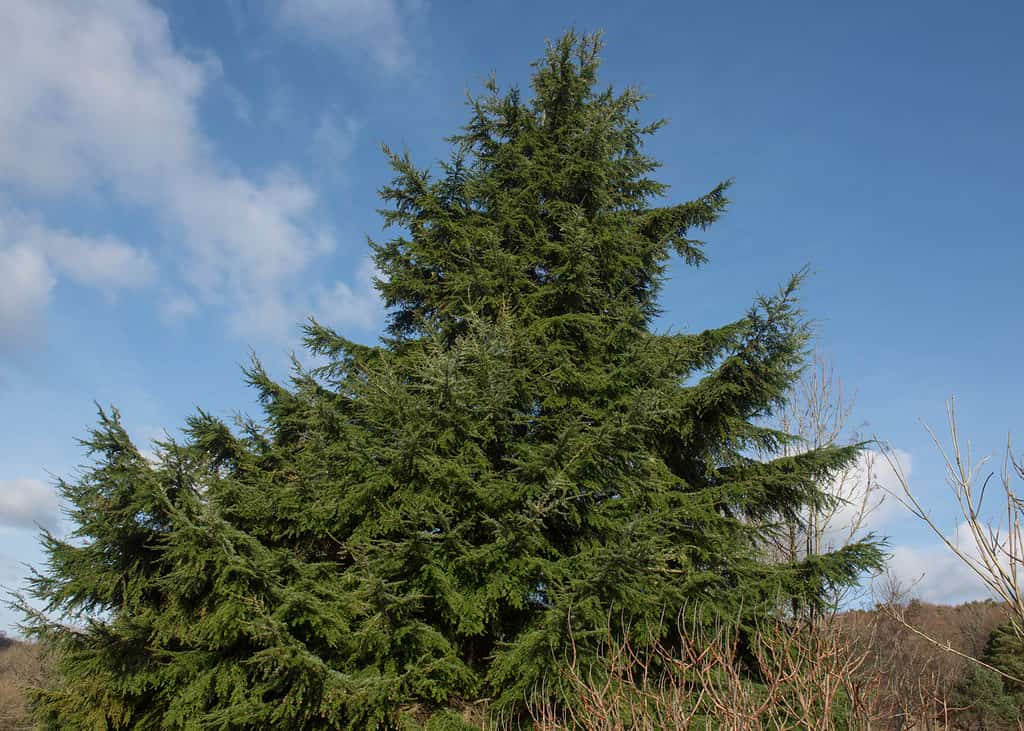
In Alaska, the western hemlock is one of the most commonly seen tree species.
©Peter Turner Photography/Shutterstock.com
The western hemlock (Tsuga heterophylla) is a native tree to Alaska. It is the most abundant tree species on the Kenai Peninsula. It’s native to the Pacific coast region spanning southern Alaska. While the western hemlock is the official name, Alaskans refer to the tree as the Alaskan spruce.
Western hemlock can grow up to 273 feet tall and have a diameter of 9 feet. Notable features include needle-like leaves that are broad and strong. They have a mid to dark green hue with two white bands of stomata.
Aside from the tree’s use as a home for wildlife, the tree was a popular source of tannin used for tanning leather. It’s also been known to be an ornamental tree for gardens or planted on riverbanks to help reduce erosion. Aside from that, parts of the western hemlock, such as the cambium, are consumable. Lastly, the trees have been submerged to collect herring eggs.
#2: Mountain Hemlock (Tsuga mertensiana)
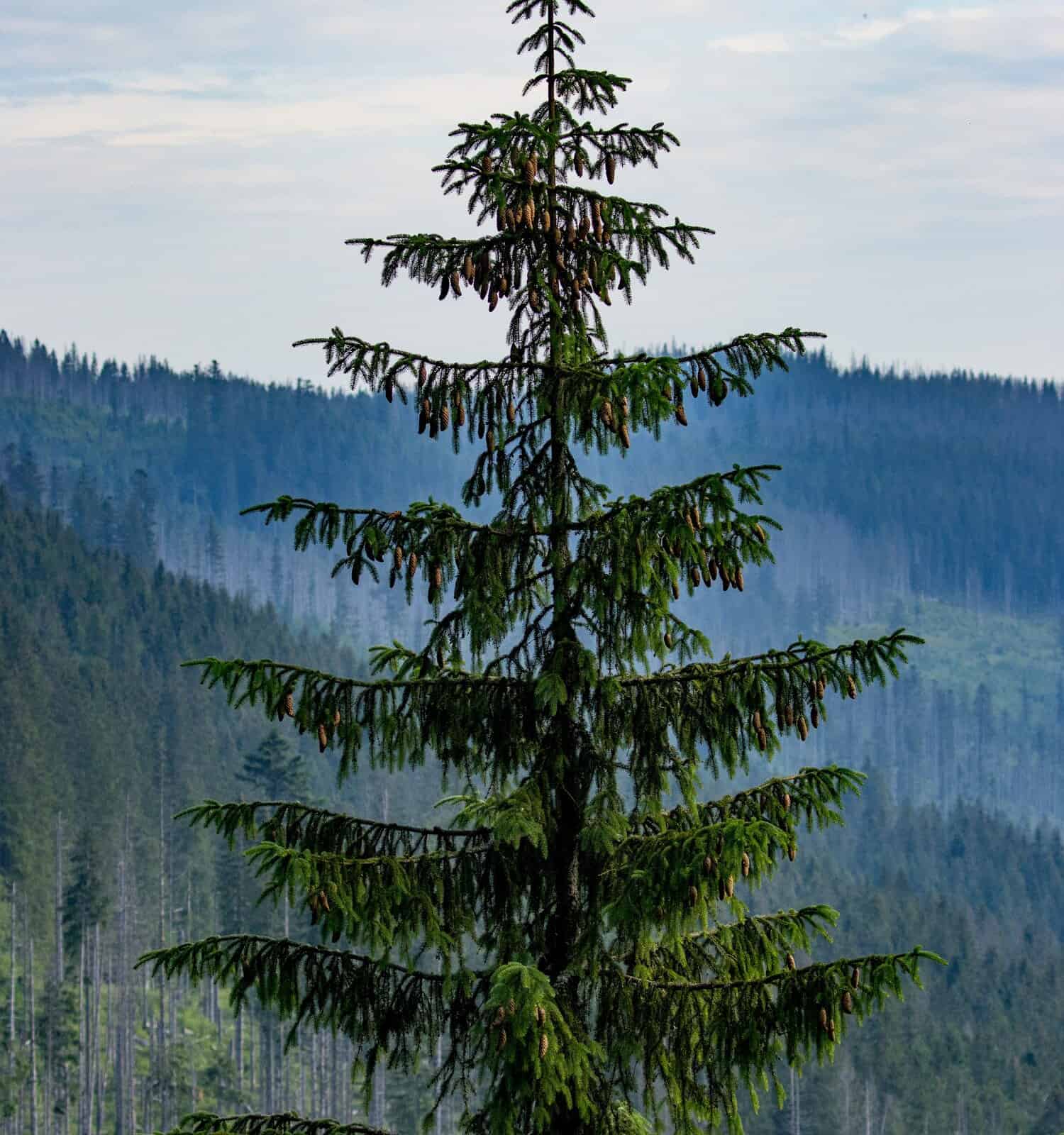
The Mountain hemlock is similar to the western hemlock, but the main difference is the distinctive leader droops and needling of equal length around the twigs.
©Wirestock Creators/Shutterstock.com
The mountain hemlock (Tsuga mertensiana) is a tree species common on North America’s west coast. In the state of Alaska, you can often find this species growing in the upper slopes of the mountain ranges along the Gulf of Alaska coast in the southeastern region. This includes Kenai, Chugach, Fairweather, and Chugach areas.
The tree is known to grow to 131 feet and has a diameter of six and a half feet. The signature colors are the purplish brown or gray bark. The leaves resemble needles and have a pale blue-green hue. The broad bands are bluish-white stomata with green midrib bands in the middle.
Native Americans used mountain hemlocks as beds and bathing brushes using the boughs. However, modern-day uses include using it for lumber or as an ornamental tree.
#3: Alaska Yellow Cedar (Callitropsis nootkatensis)

An Alaska yellow cedar is one of the most abundant trees in the southeast region.
©LapaiIrKrapai/Shutterstock.com
The Alaska yellow cedar (Callitropsis nootkatensis) is a part of the cypress family. It can be found in the northwestern regions of North America. For Alaska, the tree species can be found in the southeastern region near bogs and peatlands.
Trees of this species are known to grow up to 131 feet tall and have a width of 13 feet. The bark of the tree has a smooth surface and a purplish hue. Unlike other trees, this one doesn’t have leaves but branches in flat sprays and dark green scaled leaves. One distinctive trait is the scaled “cones” that are similar to other trees but instead are smaller in size.
In Alaska, these trees are used to create various tools. The most notable are totem poles, where the logs would be carved and painted. Other items created were canoe paddles, chests, dishes, and tools.
#4: Western Red Cedar (Thuja plicata)
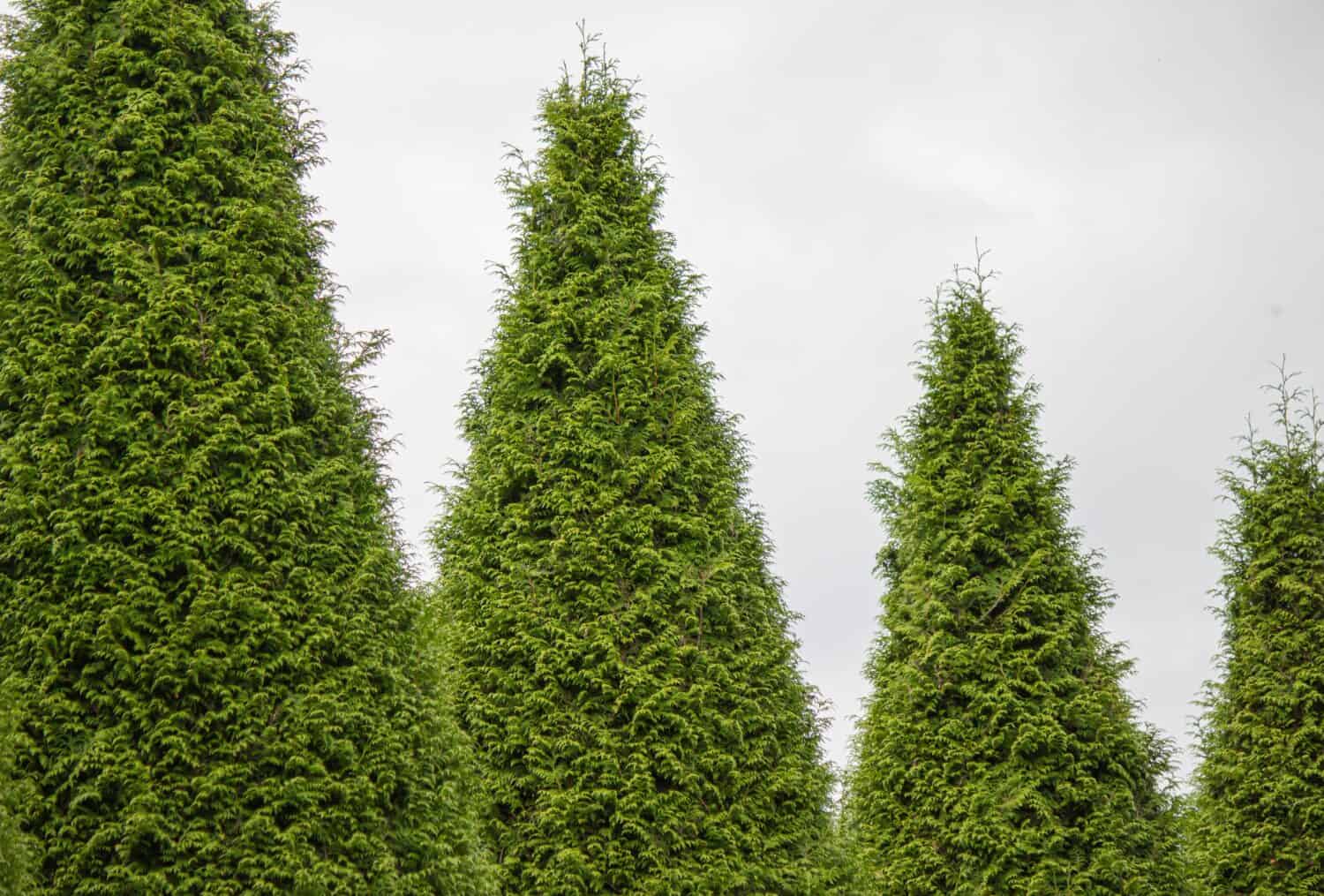
The western red cedar only grows and thrives below elevations of 500 feet.
©Wirestock Creators/Shutterstock.com
The western red cedar (Thuja plicata) is an evergreen coniferous tree in the Cupressaceae family. It’s found in Prince William Sounds and the surrounding areas in Alaska. However, it’s not found beyond the Fredrick Sound region.
Unlike other tree species, the western red cedar is relatively large, can grow to 230 feet, and is 23 feet in diameter. Its trunk is wider at the base, and the bark is thin and gray-brown with vertical bands. The leaves form in flat sprays opposite to each pair and are green in color with white bands.
In Alaska, wood is used for numerous purposes, including canoes, totem poles, and tools. The bark is also popular amongst Alaska natives to create rope and clothing. The bark is rot-resistant, aromatic, smells like crushed pineapples, and waterproof. In older buildings, the shingles and sidings use western red cedar.
#5: Sitka Spruce (Picea sitchensis)

A Sitka spruce was commonly used by Alaska Natives to craft glue, medicine, and tools.
©iStock.com/Brittany Olson
The Sitka spruce (Picea sitchensis) is an evergreen tree that is coniferous and found in Sitka, AK. It’s native to southern Alaska and mainly found on Kodiak Island and around Cook Inlet. This is located in the southeastern region of Alaska.
Growing to almost 330 feet tall, the tree is one of the largest in the state. Additionally, the base of the trunk’s diameter can grow to 16 feet. The tree’s base is thin, scaly, and reddish-brown. The tree’s crown has branches that don’t form lower than 98 feet, leaving the base branchless. Each leaf is stiff, sharp, and needle-like.
Native Alaskans favored the tree bark for crafting baskets or rain hats. The pitch of the tree was also used for its medicinal properties. Parts of the tree were also used, such as resin for glue and the roots for cords. Today, the Sitka Spruce is popular in the timber and paper industries and, in other areas of the country, is used to craft instruments such as pianos, violins, and guitars.
#6: White Spruce (Picea glauca)
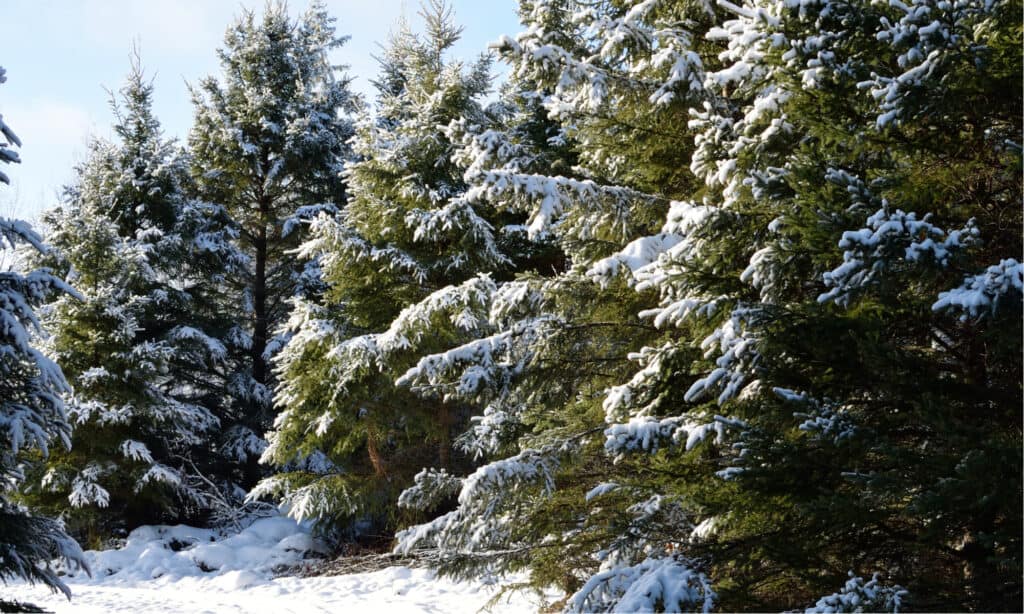
Animals find the white spruce perfect for burrowing in.
©ClubhouseArts/Shutterstock.com
The white spruce (Picea glauca) is found in boreal forests in North America and is a part of the spruce family. In Alaska, you can find the White Spruce in the interior boreal forests that are in the Kenai Peninsula. This includes the Alaska and Brooks Range, specifically Yukon, Kuskokwim, and Copper River Systems.
The tree can grow up to 130 feet tall and have a trunk diameter of 3 feet. Due to its small diameter, the bark is also thin and flakey and has a pale buff-brown color. The leaves are needle-like and feature a rhombic cross-section with a blue-green hue. There are also a few blue-white stomata lines on the leaf.
The white spruce has many uses, including fortifying shelters and being used as firewood. It was popular as an alternative to lodgepole pine, as some areas of Alaska had no other sturdy trees. However, many people use them as Christmas trees, or the tips are used for beer, gin, pop, and candy flavoring.
#7: Black Spruce (Picea mariana)
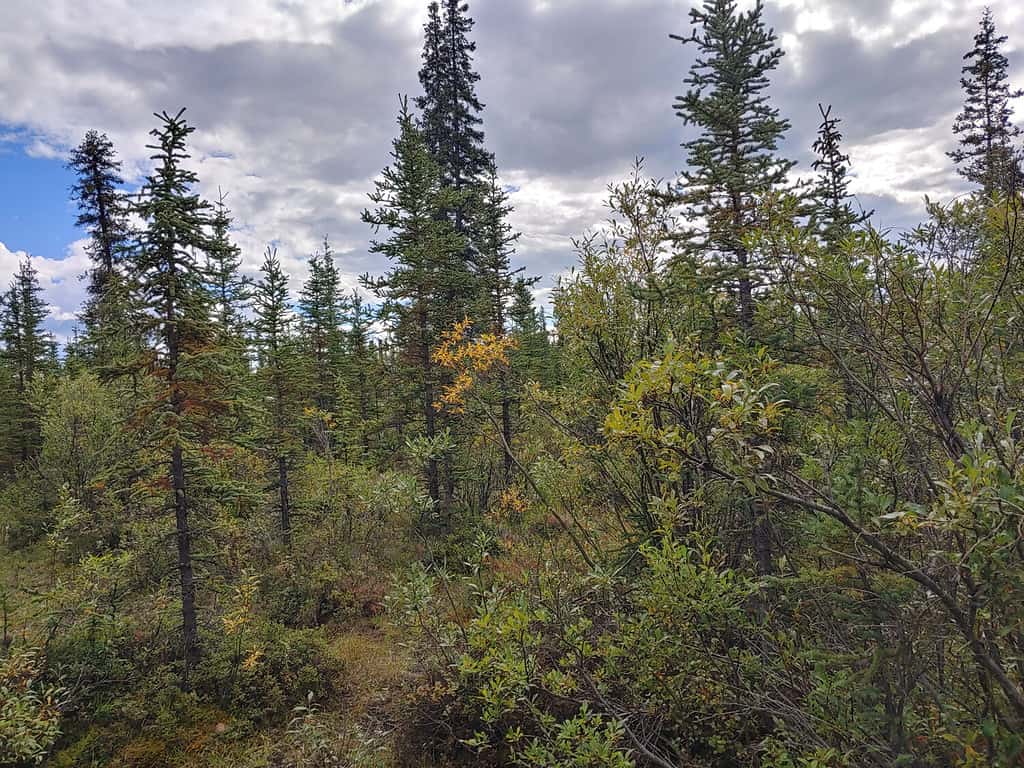
A Black spruce tree can live up to 200 years.
©Nungasak/Shutterstock.com
The black spruce (Picea mariana) is a part of the pine family located across North America. It occurs in bogs and wet lowlands. These regions are often in interior, south-central, southwestern, and northwestern Alaska.
Known for being a slow-growing tree, it can grow up to 98 feet tall with a trunk diameter of 24 inches. Its distinctive grayish-brown bark is noticeably thin, while the leaves are needle-like and dark bluish-green. Cones are also common on this tree and often are uniquely dark purple or red-brown colored while being spindle-shaped.
Unlike other tree species in Alaska, the black spruce isn’t worth much. While timber can be used, it often isn’t due to its low value. However, it is a crucial part of pulpwood in other countries, mainly Canada. The thin trunk and texture make it ideal for creating fast-food chain chopsticks, spruce gum, or beer.
#8: Shore Pine (Pinus contorta var. contorta)
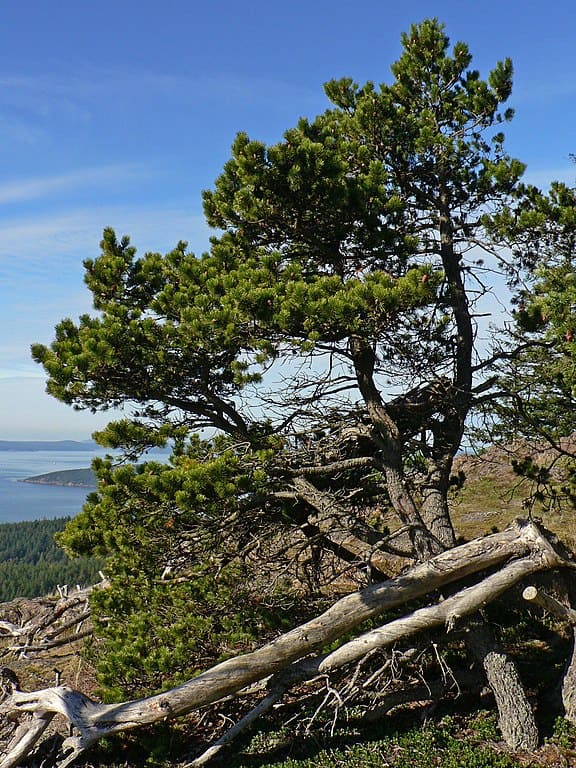
Alaska has more than 6,640 miles of coastline, an ideal area for Shore Pine to grow.
©Walter Siegmund / CC BY-SA 3.0 – License
Shore pine (Pinus contorta) is known by many names, mainly lodgepole pine, shore pine, twisted pine, and contorta pine. It’s one of the most commonly seen trees in western North America. It is a part of the evergreen conifer and pine family. It can be found in southeastern Alaska near Juneau, Hoonah, Wrangell, and Mitkof.
The tree is known to grow up to 160 feet high and has a trunk base of seven feet. Distinctive features include a rounded crown, flat top, and grayish-brown bark. The foliage looks almost egg-like with reddish-brown coloring. There are also shiny needles that point outward and are serrated. Cones also form on trees over ten years old and are scaled.
Alaska Natives used the shore pine as medicine to help protect open sores. In addition, lumber is valuable and can be used to craft cabinets, paneling, and other finishing work. Shore pines are occasionally used as Christmas trees due to their hearty stature.
#9: Tamarack (Larix laricina)
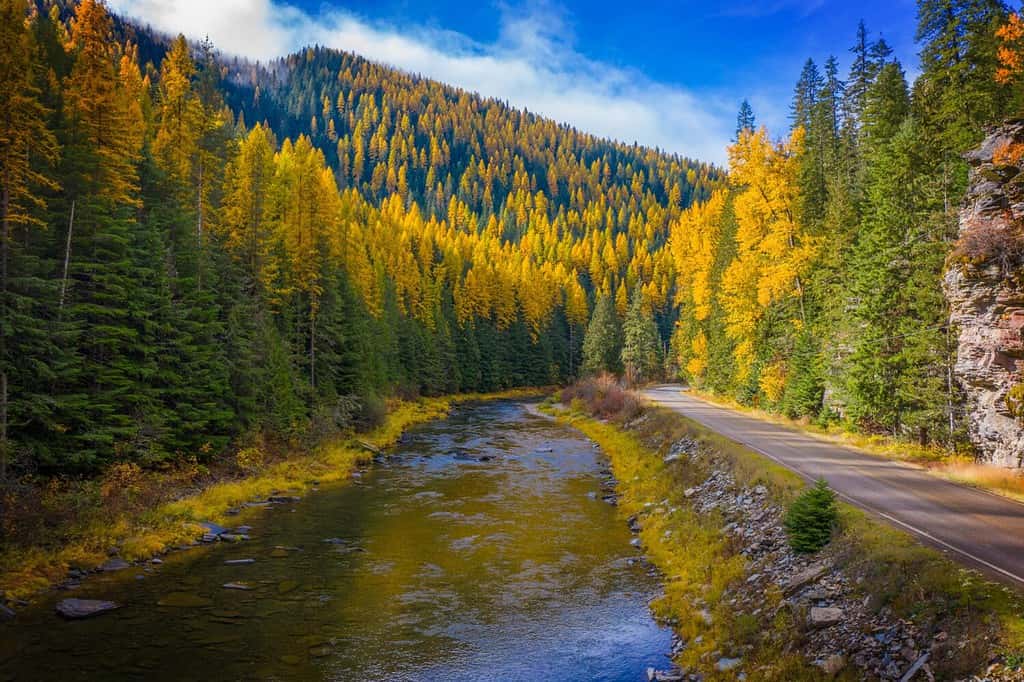
Alaska has some dry soil located in the central area, perfect for Tamarack to thrive.
©Jonathan Kroeker/Shutterstock.com
The tamarack (Larix laricina) has many names but is mainly known as the hackmatack, eastern, black, red, or American larch. The tree species are found in the eastern Yukon area, central Alaska, and inside the northeastern region of the United States. The Tamarack can grow 66 feet tall with a 24-inch diameter base.
When looking at its bark, the color is almost pink, yet it has a flaky texture. However, sometimes the bark can also appear a reddish hue. The leaves on the tree are needle-like and are a light blue-green color. The leaves will turn yellow in the fall before becoming a pinkish-brown shoot in spring.
The tamarack tree is often found in interior Alaska and is used for numerous purposes. Young stems of the tree are often used to create dogsled runners and boat ribs. Alaska Natives also use them for creating fish traps.
#10: Paper Birch (Betula neoalaskana)
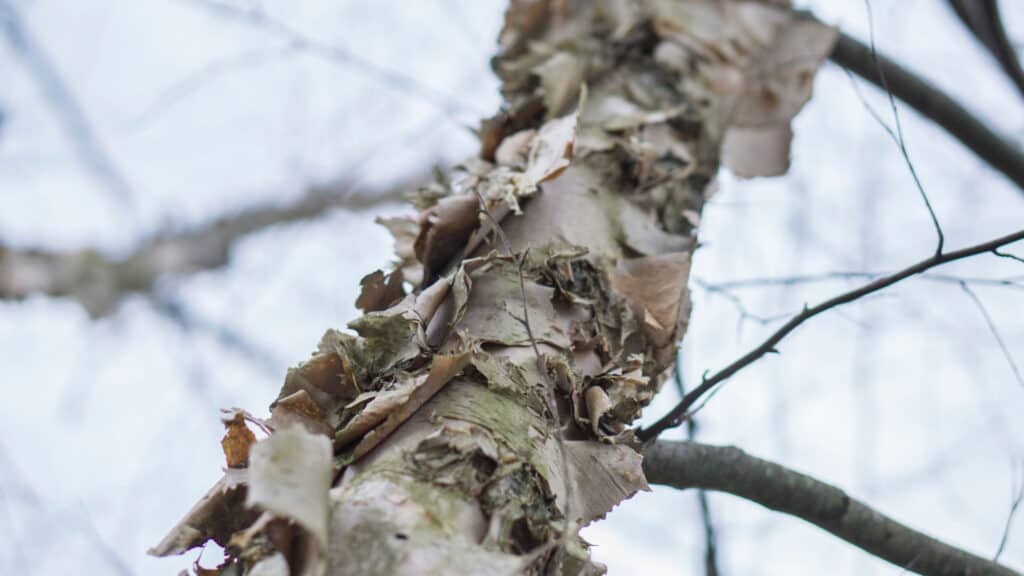
The paper birch’s bark is waterproof and can easily be peeled off the tree and used to craft tools and baskets.
©thematthewhyatt/Shutterstock.com
The paper birch (Betula neoalaskana) goes by the name white birch or the canoe birch. It’s known to grow up to 66 feet high and have a base trunk diameter of 30 inches. Paper birch is a unique tree species. It is always the first to grow and spread after an area is buried. However, it’s mainly only found in northern latitudes, including interior Alaska.
The bark varies in color depending on its age. A paper birch that is white is often older and has flaking that has pink or salmon-colored underneath. The leaves are generally dark green and are oval-shaped. Many of the leaves are serrated and have sharp teeth, expanding to one inch long.
Paper birch is a popular material for walls and roofing. However, other populations have used wood to make canoes. Since the bark is waterproof, it is a popular choice for constructing containers or wrappings. The inner bark is a lovely color and can be used as a dye.
#11: Balsam Poplar (Populus balsamifera)
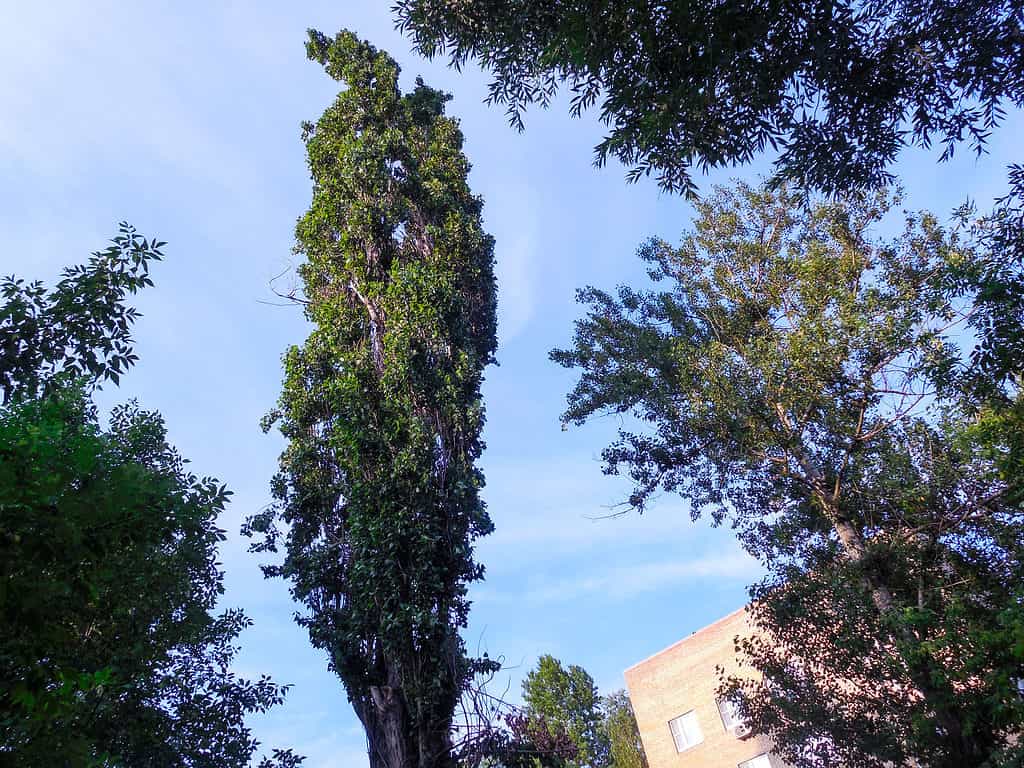
A balsam poplar tree has a white waxy coating on its underside.
©Marina Bakusheva/Shutterstock.com
The balsam poplar has many names, some being the bam, bamtree, eastern balsam-poplar, hackmatack, tacamahac poplar, and the tacamahaca. It’s officially the northernmost North American hardwood tree commonly found in interior, south-central, and southwestern Alaska.
There are multiple subspecies of balsam poplars, all located in Alaska. On average, these trees reach 150 feet with a maximum of 12 feet trunk diameter. Since the tree is a heartwood, it grooves while the bark becomes a grayish brown. The Balsam Poplar leaves are generally shiny, dark green, and have a broad lance shape.
Unlike other tree species in Alaska, the balsam poplar is mainly used as an ornamental tree. Aside from that, Alaskans use them for lumber.
#12: Quaking Aspen (Populus tremuloides)
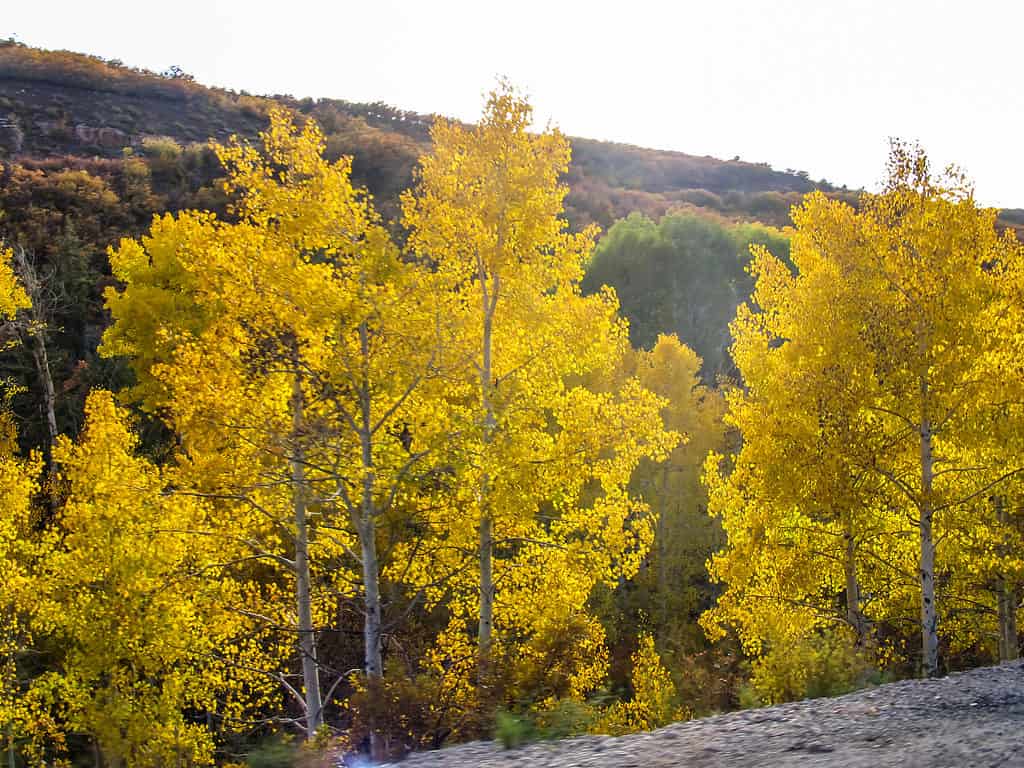
The quaking aspen does best in areas that don’t have a risk of permafrost, and it thrives in spruce forests.
©iStock.com/Marieke Peche
The quaking aspen (Populus tremuloides) thrives in cool areas located in North America. In Alaska, it’s commonly found in the south-central region and inside the boreal zone’s west and north boundaries. These trees often are inside mountain ranges and thrive on upper slopes.
The tree can often grow to be up to 119 feet in height and have a trunk diameter of 6 inches. With relatively smooth bark, the tree is a whitish color with black horizontal scars. The tree leaves are round but can be green and gray. As the season turns to fall, the leaves turn yellow and red.
Quaking aspens can be used to create fuel and also for paper production. The tree is also sturdy and used to create furniture, particle boarding, and hamster bedding.
#13: Red Alder (Alnus rubra)

The red alder species are invasive and are the first to populate areas damaged from landslides, logging, and fires.
©Danita Delimont/Shutterstock.com
The red alder (Alnus rubra) is native to North America and can be found on the west coast. In Alaska, red alder can be found close to large bodies of water, such as the state’s southern areas. In addition, these trees mainly grow in areas with elevations below 2,450 feet.
This tree species is one of the biggest alders in North America and can grow up to 105 feet. Its base trunk diameter can grow anywhere from 10 to almost 20 inches. A distinctive ashy-gray bark is often found on the Red Alder but also has white lichen and moss growing over it. The leaves are bluntly serrated and tend to be a distinctive dark green except during the fall.
The red alder’s leaves have medicinal properties and were used by Native Americans to help relieve indigestion. Today, they are a tonic alternative but are rarely used by modern medicine. Alaskan Natives used the tree for its potential anti-tumor activity using the stem bark.
#14: Scouler’s Willow (Salix scouleriana)
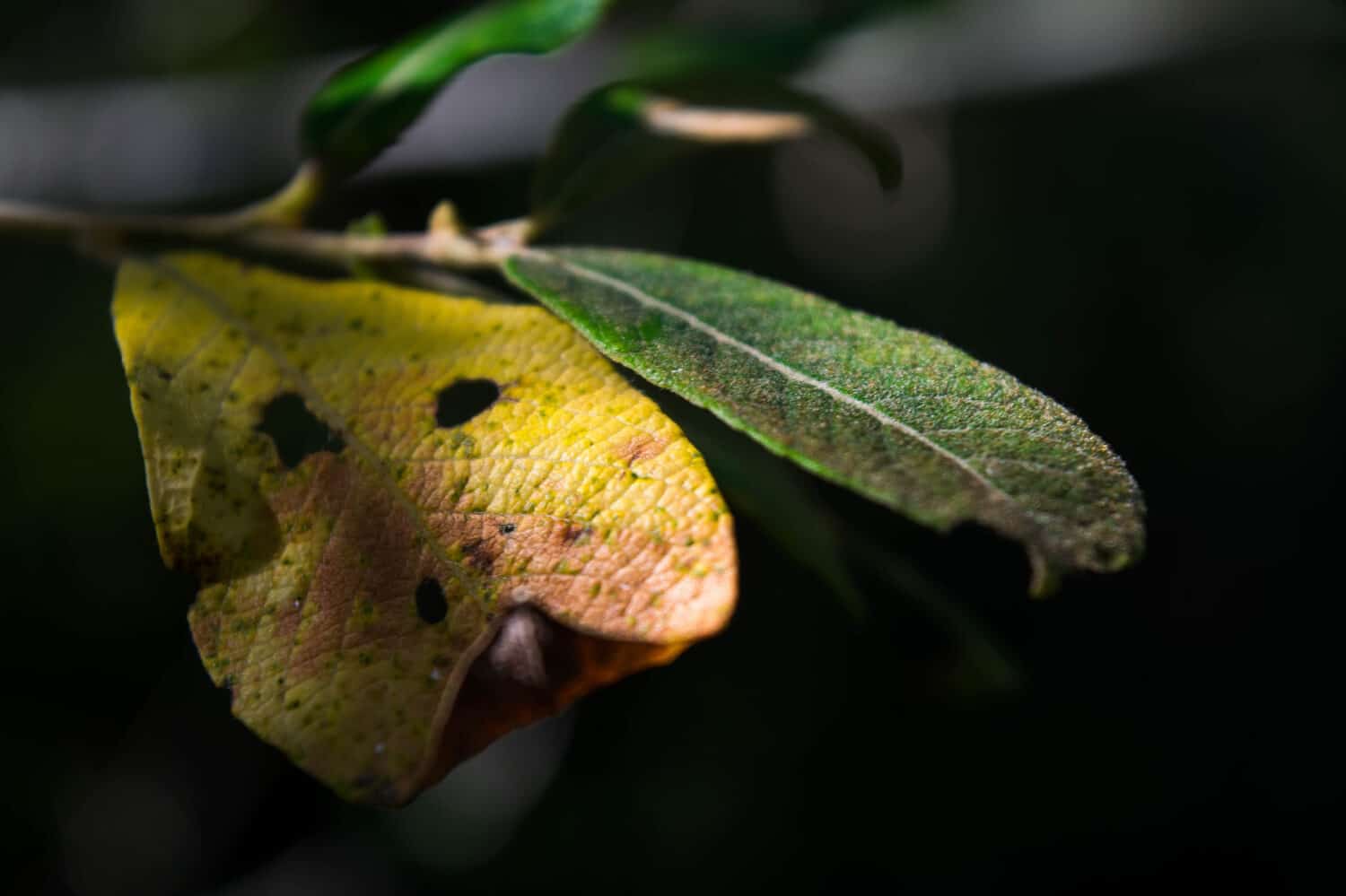
Scouler’s willows are classified as a small tree species, even though they are a part of the willow family.
©Edward Pritchard3/Shutterstock.com
The Scouler’s willow (Salix scouleriana) is native to the northwestern region of North America. The tree is known by a few names, which include the fire, Nuttall, mountain, and black willow. In Alaska, the Scouler Willow can be found in boreal forests throughout the state.
At first, the Scouler’s will start as a small shrub before forming into a tiny tree. The tree’s height can reach 66 feet, and it has almost no trunk base. The tree stems are gray or dark brown and are extremely thin. The leaves of the tree are wavy-toothed and have a dark-green color.
The Scouler’s willow has been used for multiple purposes, especially in Alaska. Alaska Natives used it for hunting and fishing, such as crafting tools and traps. In addition, the bark is extremely flexible, allowing for creating baskets, storage, or even nets.
Summary of the Most Iconic Trees Native to Alaska Chart
| Number | Tree | Scientific Name | Height (feet) |
|---|---|---|---|
| #1 | Western Hemlock | Tsuga heterophylla | 273 |
| #2 | Mountain Hemlock | Tsuga mertensiana | 131 |
| #3 | Alaska Yellow-Cedar | Callitropsis nootkatensis | 131 |
| #4 | Western Redcedar | Thuja plicata | 230 |
| #5 | Sitka Spruce | Picea sitchensis | 330 |
| #6 | White Spruce | Picea glauca | 130 |
| #7 | Black Spruce | Picea mariana | 98 |
| #8 | Shore Pine | Pinus contorta | 160 |
| #9 | Tamarack | Larix laricina | 66 |
| #10 | Paper Birch | Betula neoalaskana | 66 |
| #11 | Balsam Poplar | Populus balsamifera | 150 |
| #12 | Quaking Aspen | Populus tremuloides | 119 |
| #13 | Red Alder | Alnus rubra | 105 |
| #14 | Scouler’s Willow | Salix scouleriana | 66 |
What Is the State Tree of Alaska?
The state tree of Alaska has been the Sitka spruce (Picea sitchensis) since 1962. The Sitka spruce was named after the Sitka Sound, which is located in Alaska. It’s currently the tallest conifer worldwide. This tree grows to be the tallest due to the ocean air and summer fogs within the southern Alaska area.
Aside from its appearance, the Sitka spruce plays a vital role in Alaska’s ecosystem. Bald eagles favor the Sitka spruce trees, which are good roosting areas. In addition, many wildlife, such as deer, elk, rabbits, bears, and other mammals, use foliage for food.
In modern-day Alaska, the Sitka spruce is the most important tree for timber. Not only is it used to craft many tools, but it’s also ideal for crafting some of the most unique instruments. For tools, people use the tree to craft ladders, oars, and masts. Wood is used to make pianos, guitars, and violins for instruments!
How Many Trees Are in Alaska?
The state of Alaska has nearly 31,750,000,000 trees inside its borders. For comparison, Alaska has the most trees in a state for all of the United States. While this might not seem like a lot, there are around 43,401 trees for each person in the state. This sounds like a low number compared to other states, but Alaska has a lower population than other areas.
What Trees Are Native to Interior Alaska?
Interior Alaska spans over 175,000 square miles and is within a boundary between the Alaska and Brooks Range. This area has a plethora of trees, and these six species of trees are native to the area:
- White spruce
- Black spruce
- Quaking aspen
- Balsam poplar
- Tamarack
- Paper birch
Conclusion
Alaska is full of foliage in every region, and each tree is important to the state’s ecosystem. Not only that, but the Alaska Native tribes found many of these native trees to be useful for survival. These days, these 14 most iconic trees native to Alaska still help wildlife and humans by being a valuable resource.
The photo featured at the top of this post is © melissamn/Shutterstock.com
Thank you for reading! Have some feedback for us? Contact the AZ Animals editorial team.






